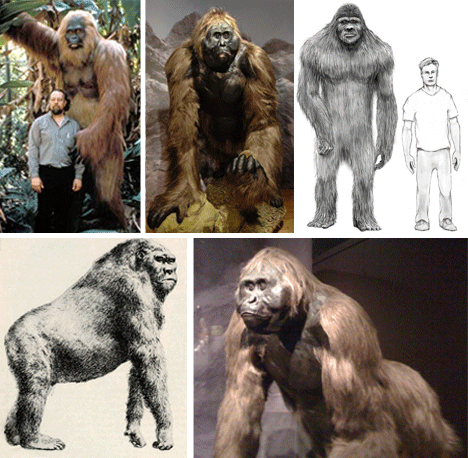Did Bigfoot Really Exist? How Gigantopithecus Became Extinct
Posted by: Craig Woolheater on February 19th, 2015

Dental, dietary and environmental clues help explain why the world’s largest ape vanished
Scientists first learned of Gigantopithecus in 1935, when Ralph von Koenigswald, a German paleoanthropologist, walked into a pharmacy in Hong Kong and found an unusually large primate molar for sale. Since then, researchers have collected hundreds of Gigantopithecus teeth and several jaws in China, Vietnam and India. Based on these fossils, it appears Gigantopithecus was closely related to modern orangutans and Sivapithecus, an ape that lived in Asia about 12 to 8 million years ago. With only dentition to go on, it’s hard to piece together what this animal was like. But based on comparisons with gorillas and other modern apes, researchers estimate Gigantopithecus stood more than 10 feet tall and weighed 1,200 pounds (at most, gorillas only weigh 400 pounds). Given their size, they probably lived on the ground, walking on their fists like modern orangutans.
Fortunately, fossil teeth do have a lot to say about an animal’s diet. And the teeth of Gigantopithecus also provide clues to why the ape disappeared.
The features of the dentition—large, flat molars, thick dental enamel, a deep, massive jaw—indicate Gigantopithecus probably ate tough, fibrous plants (similar to Paranthropus). More evidence came in 1990, when Russell Ciochon, a biological anthropologist at the University of Iowa, and colleagues (PDF) placed samples of the ape’s teeth under a scanning electron microscope to look for opal phytoliths, microscopic silica structures that form in plant cells. Based on the types of phyoliths the researchers found stuck to the teeth, they concluded Gigantopithecus had a mixed diet of fruits and seeds from the fig family Moraceae and some kind of grasses, probably bamboo. The combination of tough and sugary foods helps explain why so many of the giant ape’s teeth were riddled with cavities. And numerous pits on Gigantopithecus‘s teeth—a sign of incomplete dental development caused by malnuntrition or food shortages—corroborate the bamboo diet. Ciochon’s team noted bamboo species today periodically experience mass die-offs, which affect the health of pandas. The same thing could have happened to Gigantopithecus.
Further evidence of Gigantopithecus‘ food preferences and habitat was published last November. Zhao LingXia of the Chinese Academy of Sciences and colleagues analyzed carbon isotopes in a sample of Gigantopithecus teeth. Plants have different forms of carbon based on their type of photosynthesis; this carbon footprint is then recorded in the teeth of animals that eat plants. The team determined Gigantopithecus—and the animals living alongside it, such as deer, horses and bears—ate only C3 plants, evidence the ape lived in a forested environment. This work also supports the proposed bamboo diet, as bamboo is a C3 plant.
So what happened to this Pleistocene Yeti? Zhang’s team suggested the rise of the Tibetan plateau 1.6 million to 800,000 years ago altered the climate of South Asia, ushering in a colder, drier period when forests shrank. Other factors could have exacerbated this crisis. Gigantopithecus‘s neighbor, Homo erectus, may have over-hunted and/or outcompeted their larger ape cousin. And at least one dental study indicates Gigantopithecus developed and matured very slowly—a sign they probably had low reproductive rates, which can elevate a species’ risk of going extinct.
Some Bigfoot hunters say Gigantopithecus is alive and well, hiding out in the forests of the Pacific Northwest. Other Sasquatch enthusiasts, however, point out this is unlikely, as Bigfoot is reported to be a swift, agile, upright walker—not a lumbering, 1,200-pound quadruped.
Source: Smithsonian.com
About Craig Woolheater
Co-founder of Cryptomundo in 2005.
I have appeared in or contributed to the following TV programs, documentaries and films:
OLN's Mysterious Encounters: "Caddo Critter", Southern Fried Bigfoot, Travel Channel's Weird Travels: "Bigfoot", History Channel's MonsterQuest: "Swamp Stalker", The Wild Man of the Navidad, Destination America's Monsters and Mysteries in America: Texas Terror - Lake Worth Monster, Animal Planet's Finding Bigfoot: Return to Boggy Creek and Beast of the Bayou.









If sasquatch is ever confirmed (which, unfortunately, I don’t think likely), I would not be surprised if Krantz was at least partly right and it had branched off the Giganto line at some point. We don’t have a human type remotely large enough (folktales and 19th-century newspapers aside) to account for it.
Like Matt Bille, I am not yet convinced that Bigfoot is a real biological entity. If it is, though, I differ with Matt in expecting it to be unrelated to Giganto. Studies of body lice evolution show our own ancestors were naked and hairy until 50,000 to 200,000 years ago — more recently than we diverged from Neanderthals. As for size, it is much easier to evolve a different size than to evolve all the changes needed for a man-like gait.